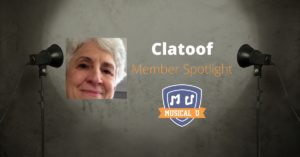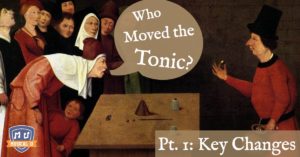And now, welcome to the exciting world of intervals!
Ok, well maybe not so exciting. But identifying the space between two notes is the magical key that unlocks the ability to play by ear, improvise, sing harmonies, better sight-reading and a whole host of skills that we call musicality.
Sounds easy, right? Well not always. In fact, at time ear training can feel like it’s downright impossible. This week we learned what to do to move past the frustration. And speaking of frustration, anyone who’s tried to learn a song by ear knows how important it is to know the tonic – the first note of the scale that points to the melody, bass line, and chords. But what happens when that tonic moves?
In the face of difficulty, determination, and training work miracles. Like when you’re switching instruments, or improving your singing and harmonizing abilities like our Musical U member Clatoof.
A New Voice
 Musical U is blessed with astonishing variety among its members, from metalheads to mariachis. What they share in common is a passion for music and a desire to support others in their musical growth.
Musical U is blessed with astonishing variety among its members, from metalheads to mariachis. What they share in common is a passion for music and a desire to support others in their musical growth.
When Clatoof was suddenly moved from the alto to the soprano section of her church choir, she felt much more exposed and wanted to feel more confident. So in her 50s, she joined Musical U. Her first focus was on intervals, and now she’s branching out, learning to harmonize at her husband’s jam sessions, and even how to sing and play piano at the same time. Find out how Musical U has helped her along her journey in our Musical U Member Spotlight: Clatoof.
Moving Target
When we study intervals, we are learning relative pitch. But relative pitch is most useful when we have some central note to relate too.
 The tonic is the first note of a scale, and shines like the sun in the musical solar system of a song. When we know the tonic, we can locate the “planets” (the notes) in the melody – solfa and intervals are both great for that. What’s more, we can predict and hear the most likely bass lines and harmonies.
The tonic is the first note of a scale, and shines like the sun in the musical solar system of a song. When we know the tonic, we can locate the “planets” (the notes) in the melody – solfa and intervals are both great for that. What’s more, we can predict and hear the most likely bass lines and harmonies.
But what happens when – gasp! – the composer moves the tonic. Yes, this happens. A lot.
Learn how to expand your same solfa and interval ear training skills to mapping out these modulations in Who Moved the Tonic? Part 1: Hearing Key Changes
Composers love to change keys and pop music is no exception. Pop Music Theory discusses how to hear modulations in music, using a Lady Gaga song as an example.
Would you like some additional training on how to hear modulations? Music Matters offers this video tutorial on how to listen to and recognize a key change within a short piece of music.
Our friends Bob and Paul at Shed the Music have put together an excellent resource on Solfa. From an introduction to practice exercises, this is a great guide for all musicians.
Determination
 Composer (comedian, and biomedical engineer) Kangyi Zhang began his musical journey as a third choice school elective. At 19, he thought it would be easy to switch from the Chinese dizi flute to Western flute.
Composer (comedian, and biomedical engineer) Kangyi Zhang began his musical journey as a third choice school elective. At 19, he thought it would be easy to switch from the Chinese dizi flute to Western flute.
Surprise! Not easy.
But in the disciplined, determined, and patient process of becoming a Western flute player, he discovered the wide range of crazy contemporary Western flute techniques and timbres and his own voice as a composer. Join him on A Flutist’s Journey, with Kangyi Zhang.
Kangyi got his start on what is called a “dizi”, but what exactly is it and where did it come from? Eason Music School answers all of your dizi-related questions.
Mak Jo Si of Chi in Nature explains the differences between the Chinese flute to the Western flute in this video:
Who says an old instrument can’t learn new tricks? The most exciting new music being composed and performed in East Asia is for traditional Asian instruments, according to New Music Box.
The Right Way to Ear Train?
Even when you’ve recognized the value of learning intervals and taken the steps to do so, there are still many choices and to make. And it isn’t always smooth sailing.
In fact, sometimes it can seem well nigh impossible.
The truth is, there is no one “right way” to ear train – and there are lots of ways to go wrong as well. Ear training is not one-size-fits-all.
 That’s why Musical U has developed a multi-layered flexible training system weaving together different approaches and personal expert guidance.
That’s why Musical U has developed a multi-layered flexible training system weaving together different approaches and personal expert guidance.
Is ear training impossible? It’s time to answer this question once and for all.
If you’re having trouble hearing intervals, maybe it’s a good opportunity go back to ear Training 101. Learn Jazz Standards takes you back to the basics with this intervals ear training test.
Why should you make the extra effort to learn to hear intervals? Fretjam explains why intervals are the key to unlocking amazing ear skills.
Interval ear training isn’t just for singers – it benefits all musicians. In this video tutorial from Center Stage Guitar Academy, you will be guided on how to identify intervals of the major scale.
Whether you aspire to be a globetrotting composer or to jam at home with friends, you’ll enjoy it all a whole lot more once you’ve made friends with those pesky little intervals. It may not always be smooth sailing but – when you allow yourself the freedom to correct your course and reach out for the guidance of those who have gone before you – you may find the journey will lead you to unexpected musical delights.







